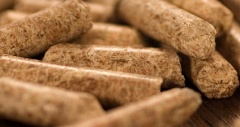Bagasse Pellets (in bulk)
| Infobox on Bagasse Pellets (in bulk) | |
|---|---|
| Example of Bagasse Pellets (in bulk) |  |
| Facts | |
| Origin | - |
| Stowage factor (in m3/t) | - |
| Humidity / moisture | - |
| Ventilation | - |
| Risk factors | See text |
Bagasse Pellets (in bulk)
Description
Bagasse is the residue of sugar cane which has been dried out of water, which can meet the standard of pellet raw material. If you just let the bagasse decay, it will release methane, and that’s 20 percent more dangerous to the ozone layer.
Bagasse in Brazil is used to provide energy for cogeneration plants or national grid, but there are still around 25 million tons which are not used. If those 25 million tons of sugar cane waste can be transformed into pellet fuel, it will make great benefit and profit to meet the growing demand of pellet fuel on the market.
For making bagasse into fuel, a pellet mill is required. Firstly, the bagasse is processed into powder. There are a die and a set of rollers inside the pellet mill. The rotary roller will press the bagasse powder out of the hole of the die into small granules. Outside of the mill, there will be cutters to shorten the granule with the length between 3 and 5 cm. Besides pelletizing, there are still other processes including crushing and drying the raw material, and cooling and packaging the pellets. That is to say, besides pellet mill, other auxiliary accessories are needed together with crusher, dryer, cooler and packaging machine to make up a total pellet making production line.
Shipment / Storage
Dust may form flammable / explosive mixtures with air and all possible sources of ignition should be kept away during stuffing, carriage and unstuffing. It has a strong smell and is corrosive when in contact with steel; also liable to heating / spontaneous combustion. Bagasse should not be loaded during rain.
Temperature prior to stuffing should be less than 40°C and a certificate from shippers shall mention particulars with regard to moisture content, temperature and number of days of exposure to the open air.
Temperatures shall be taken twice daily during the voyage and when the temperature increases, surface ventilation will be permitted. If the temperature reaches 50°C., ventilation must be stopped. In case of fire, suppress with CO2.
Risk factors
Reference is made to the relevant IMO regulations on hazardous cargo (when referred to Seedcake).











